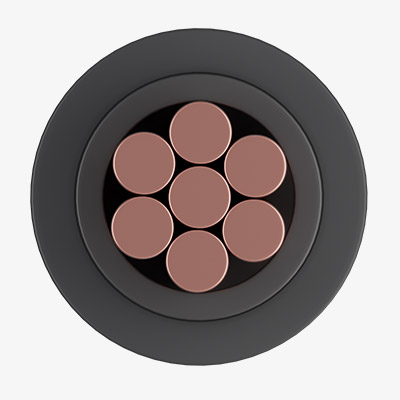TRATOS® XLPE/PVC
Cathodic Protection Cable

Cross-linked Polyethylene (XLPE) insulated, Polyvinylchloride (PVC) sheathed, single core cable.
Tratos single core XLPE/PVC unarmoured cable is designed for use as the connecting cable in non-demanding cathodic protection systems worldwide.
Because of its many benefits, Cross-linked polythene (XLPE) is now used almost universally as insulation on LV cables. Polyethylene, which is thermoplastic, is transformed into an elastomeric material (XLPE) by cross-linking, which Tratos accomplished by chemical methods. Tratos cross-linked polythene has good mechanical properties and good resistance to abrasion coupled with excellent dielectric properties. Because of its elastomeric nature, it withstands high temperatures without melting or excessively deforming. XLPE has higher modulus and strength at elevated temperatures compared to HDPE it also has reduced creep and sensitivity to stress cracking. The resistance of XLPE to water is excellent, to chemicals and solvents generally good, but it has rather poor resistance to mineral and vegetable oils. Standard XLPE compounds are not flame retardant, however, they are classed as halogen-free.
Immediately over the inner layer of XLPE Tratos extrude a thick layer of a sheathing grade of Polyvinylchloride (PVC).
Polyvinyl chloride is known universally as a good general-purpose thermoplastic. As the term suggests, the properties of thermoplastics vary with temperature, so at elevated temperatures, PVC softens, conversely at low temperatures, they become stiff and rigid; the grade of PVC used by Tratos has been carefully selected to obtain the optimum balance of properties for this application. Tratos PVC sheaths are tough and abrasion resistant, having good mechanical and ageing properties, with excellent resistance to ozone and weather, and specific resistance to UV is achieved by including carbon black in the compound. Cables sheathed with PVC have good resistance to water but for prolonged or permanent immersion, an alternative sheathing material such as polyethylene is required.
PVC has good resistance to chemicals but can be affected by solvents and some oils, which tend to leach out the plasticiser and can cause the PVC to crack. PVC compounds are classed as flame retardants, being self-extinguishing when the source of the flame is removed; PVC is, however, not halogen free and produces black smoke when burned.
Tratos XLPE/PVC cables offer performance and reliability over an extended lifetime in cathodic protection applications.

Contact us:
Tel: +44 20 3148 5178
e-mail: sales@tratosgroup.com
Please don’t hesitate to contact us if you need additional information about our products.
Application
Tratos Cathodic Protection Cables are single conductor cables that are intended to carry a DC current to anodes and cathodes in a cathodic protection system. Tratos Cathodic Protection Cables are designed for use in both active and passive cathodic protection systems to eliminate and prevent corrosion in Metals. Tratos Cathodic Protection Cables are used to eliminate and prevention the corrosion of steel pipelines and steel storage tanks, offshore oil and gas installations, offshore wind farms, ships and other maritime applications installed in air or water. Tratos XLPE/PVC Cathodic Protection Cables are intended for installation in simple non-demanding applications where the risk of mechanical damage is low.Specifications
- Conductors: Plain annealed copper conductors – BS EN 60228 Class 2
- Insulation: Cross-linked polythene (XLPE)
- Sheath: Polyvinylchloride (PVC).
- Standard size range: 10mm2 to 50mm2 (up to 400mm2 available on request)
- Standard colours are RED and BLACK
Standards
Technical Specifications
- Minimum ambient air temperature -15 oC
- Maximum continuous conductor temperature +90 oC
Minimum bending radius – Fixed Installation:
- ≤ 25mm 4D
- >25 ≤12mm 6D
Maximum allowable pulling tension:
- 50N/mm2 during installation
- 15N/mm2 in service
Additional Information
CONDUCTOR – Material: Compacted tinned annealed Cu
| Nominal CSA | Nominal Diameter | Max. resistance 20oC |
| mm2 | mm | Ω/km |
| 10 | 3.8 | 1.84 |
| 16 | 4.65 | 1.16 |
| 25 | 5.83 | 0.734 |
| 35 | 6.8 | 0.529 |
| 50 | 8 | 0.391 |
| Nominal CSA | Nominal Diameter | Max. resistance 20oC |
| mm2 | mm | Ω/km |
| 10 | 3.8 | 1.84 |
| 25 | 5.83 | 0.734 |
| 35 | 6.8 | 0.529 |
| 50 | 8 | 0.391 |
INSULATION – Material: XLPE
| Nominal thickness | Nominal Diameter |
| mm | mm |
| 0.7 | 5.2 |
| 0.7 | 6.05 |
| 0.9 | 7.63 |
| 0.9 | 8.6 |
| 1.0 | 10.0 |
| Nominal thickness | Nominal Diameter |
| mm | mm |
| 0.5 | 5.2 |
| 0.5 | 6.05 |
| 0.5 | 7.63 |
| 0.5 | 8.6 |
| 0.5 | 10.0 |
OUTER SHEATH – Material: PVC
| Nominal thickness | Nominal Diameter | Nominal weight |
| mm | mm | kg/km |
| 1.4 | 8.0 | 155 |
| 1.4 | 8.85 | 220 |
| 1.4 | 10.4 | 310 |
| 1.4 | 11.4 | 405 |
| 1.4 | 12.8 | 525 |
| Nominal thickness | Nominal Diameter | Nominal weight |
| mm | mm | kg/km |
| 1.4 | 8.0 | 155 |
| 1.4 | 8.85 | 220 |
| 1.4 | 10.4 | 310 |
| 1.4 | 11.4 | 405 |
| 1.4 | 12.8 | 525 |
Contact us
Please, don’t hesitate to contact us for additional information on our company or our products.
Other News
-
Tratos Cavi, Italian Multinational Leader in the Sector, Acquires Endurance Telnet, Dedicated to Fibre Optic Cable Production
-
Tratos Announces Strategic Expansions and Technological Innovations
-
Tratos Cavi Spa has acquired AFL Telecommunications Europe Ltd in the UK
-
Tratos Powers Up the 380kV Rondissone-Turbigo Overhead Line
-
Powering a Sustainable Future with Cables
-
Prof Maurizio Bragagni Esq OBE, CEO of Tratos Ltd, received the SSE Sustainability Supplier Awards in the Individual/Team category
-
Tratos Pioneers Sustainable Innovation in the Energy Industry with Bornewables at "The Wire" Trade Fair
-
Tratos participates in the round table on Fusion Energy









